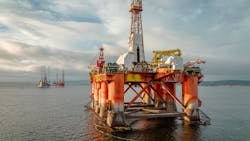Affordable offshore well monitoring lowers P&A costs
Editor's note: This story first appeared in the May-June 2023 issue of Offshore magazine as part of the Remote Inspections & Operations Special Report.
By Thierry Zois, Hiber
Every well’s life has a hard stop, but the plug and abandonment (P&A) process can feel never-ending. The P&A procedure itself costs multiple $100,000s, compounded by years of site visit costs (in terms of teams, transportation and pure opportunity cost). Can the latest satellite technology make well abandonment less painful?
Until recently, connecting wells to satellites was too expensive to be a practical solution for monitoring abandoned wells. Its power requirements made it impractical for remote applications, and networking limitations, which limited the distance between wellhead sensors and the satellite gateway, added to the hardware costs. However, the arrival of Internet of Things, along with three major technical innovations, has redefined what is possible (and affordable) with remote well monitoring:
- Long-range networks: Developments in long-range networks (LoRaWAN) have redefined the economics of satellite monitoring. LoRaWAN provides a terrestrial coverage radius of 10 km, which means numerous wellhead sensors can share a single satellite gateway, significantly reducing the complexity and cost of networking hardware.
- Bite-size data packets: Traditional 24/7 data-gathering monitoring solutions have been supplanted by a new generation of solutions that employ intelligent data gathering and transmission. Instead of beaming data continuously (which is both unnecessary and expensive), today’s smart sensors sample key data every few minutes, then transmit it each hour. While users will not receive real-time data, they will get regular updates of mission-critical information at an affordable price.
- Power optimization. Small, efficient data transmissions have enabled improved power optimization. Instead of being a power-hungry monster, new satellite well-monitoring solutions use much less energy, which translates into significantsavings for operators.
Case study
Today’s smart satellite-powered technology makes it easy to tap into remote wellhead data, plan better abandonment strategies and eliminate surprises. To see it in action, look to the North Sea, where Shell has a portfolio of old wells dating back to the ’60s and ’70s, many of which are in the process of being abandoned.
Shell had already calculated the costs of sending teams of engineers in helicopters or boats to manually collect data for 12 months or more. The company wondered whether this new satellite technology could reliably and cost-effectively monitor two platforms. Hiber’s team worked with Shell on a pilot using the HiberHilo oil and gas technology to validate its predictions. HiberHilo is a turnkey well and pipeline monitoring tool that includes sensors, software, satellite connectivity and continued service.
In April 2021, Shell’s crew installed pressure sensors on annuli that required close monitoring and network gateways to facilitate wireless satellite communication. The entire installation of the solution took less than three hours, with the sensors connected to the satellites within 15 minutes. It was so fast that the Shell engineers estimated they could have performed another 15 installations that same day. Plus, when the team started using HiberHilo, 99.8% of the data collected were logged in Shell’s monitoring system.
Instead of going offshore monthly to check for possible pressure buildups, Shell’s technical team can now continually monitor these abandoned wells and implement a comprehensive P&A strategy. This reduction in trips reduced the cost of the decommissioning campaign by an estimated €120,000 ($132,516), while at the same time improving the integrity of the decommissioning plan.
Furthermore, this approach lowered the probability of remedial work and reduced rig time, unlocking another potential €300,000 ($331,290) in savings. Importantly, the solution also improved crew safety and reduced the environmental impact of platform visits. At the end of the project, once the P&A campaign has completed, the sensors and gateways can be easily transferred to the next platform on a rolling schedule.
In conclusion, this resulted in a cost reduction and increased sustainability.
